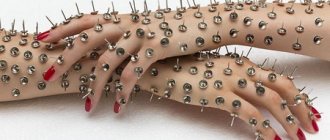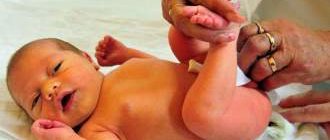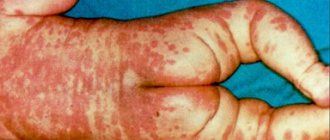About the disease
Diaper rash is irritation of the baby's delicate skin due to mechanical friction or secretions (urine, feces).
The skin often suffers in natural folds (perineum and under the arms). Inflammation primarily occurs without infection, especially with a change in diet, which changes the properties of feces. However, due to the nature of children's skin, a bacterial or fungal infection can quickly develop, requiring immediate treatment. Diaper rash most often occurs in children who are bottle-fed, have excess body weight for their age, have digestive disorders, are prone to allergies, have lactase deficiency, and abnormal kidney development. Excessive wrapping, high room temperature, untimely bathing, prolonged stay in wet diapers or a diaper of the wrong size contribute to the development of diaper rash.
In practice, to select the correct treatment method, the following classification of diaper rash is used:
- diaper dermatitis - redness and rash appear only in those places that are constantly in contact with wet diapers;
- allergic ring - occurs around the anus due to a food allergy that develops to a new food product;
- seborrheic eczema - the skin of the lower abdomen and genitals becomes rough, swollen, oily to the touch, the border with normal skin is clear, looks like a hyperemic (bright red) huge spot;
- intertrigo - affects natural folds (gluteal, elbow, popliteal and others), against the background of redness, weeping cracks form, this condition is provoked by increased humidity;
- genital candidomycosis - occurs when a fungal infection is attached, has the appearance of red spotty rashes;
- impetigo - occurs when a pyogenic infection occurs; it first appears as separate and then small draining ulcers, which form crusts after drying. Impetigo in children forms on the buttocks.
Diaper rash at the initial stage can be eliminated with good care, changing the brand of diapers and using a high-quality baby skin cream. In severe cases, etiotropic treatment is required, aimed at combating the infectious onset.
Types and stages of progression of intertriginous dermatitis:
There are three stages of development of this disease: first, second and third.
- At the first stage of diaper rash progression, slight redness of the skin appears.
- The second stage is characterized by the appearance of microcracks and a rash.
- At the third stage of dermatitis, eczema appears.
Contact dermatitis is also a type of diaper rash. This dermatitis has characteristic signs, such as excessive weeping reddish rashes on the skin. This type of disease occurs due to contact with allergic pathogens. The manifestation of dermatitis in the groin area is its second type and is called “impetigo”.
Diaper rash symptoms
Diaper rash is manifested by characteristic skin changes. From a practical point of view, the following 3 degrees of severity are distinguished:
- mild – the skin only turns red (hyperemia);
- medium - against the background of reddened skin, erosions, microcracks, and sometimes small ulcers are visible;
- severe - in addition to reddened skin and cracks, areas of erosion, ulcers are visible, the epidermis peels off in places. Almost always there is an infection, bacterial or fungal. An extreme manifestation of severe disease is microbial eczema, in which lesions are aggravated by an autoimmune process.
The baby's behavior with first-degree diaper rash does not change in any way; skin damage is detected when changing diapers. In the second degree, the child is bothered by burning, pain and itching, which is manifested by tearfulness, moodiness, anxiety, and poor sleep. The addition of a bacterial infection is manifested by an increase in body temperature, loss of appetite and other general symptoms.
Symptoms
It should be noted that after minor signs of irritation appear, diaper rash in newborns quickly progresses if measures are not taken to eliminate the provoking factors. A severe form in a child, in which treatment under the supervision of a doctor is required, can develop very quickly (in 1-2 days).
What does diaper rash look like in newborns?
If the diaper does not absorb urine enough, diaper rash appears in the groin of newborn boys, since the skin is constantly wet. In children with sensitive skin or prone to allergic reactions, irritation appears on the bottom, perineum and genital area. The likelihood of its occurrence increases if the diaper is rarely changed. This is due to the fact that when overfilled, the absorbent properties of the diaper are reduced. Redness under the arms develops when the child sweats and the delicate skin rubs against rough parts of clothing. Foci of redness have clear boundaries, and the color intensity can range from pink to bright red. Lack of care and treatment causes progression of the process - the development of superficial ulcers. It is assumed that if redness persists for three days and does not respond to treatment, the skin is infected with Candida fungi or bacterial flora.
If we consider this process in stages, then at the beginning (first stage) the irritability of the skin increases - slight and faint local redness appears.
Photo of erythematous dermatitis
In the second stage, if irritating factors are not eliminated, the skin appears bright red (inflammation), and erosions and cracks appear on the surface of the skin. Microorganisms found in feces infect the baby's irritated skin. When a microbial infection occurs, the surface becomes wet (weeping), bright red, and against the background of hyperemia, microcracks, ulcers and pustules appear. The elements spread quickly, forming large areas of skin damage.
The lesion has clear boundaries, swelling . The eroded surface may contain purulent (with a bacterial infection) or white cheesy (with a fungal infection) coating. A pustular rash may appear around diaper rash due to a bacterial infection. Such complications are accompanied by itching, pain and burning. In some cases, the temperature rises, the child is restless, cries, does not sleep, and refuses to eat. Complicated diaper rash is severe and long lasting.
Causes of diaper rash
Diaper rash occurs in almost every baby, even with ideal care.
This happens because the skin is the most vulnerable part of a baby’s body. Children's skin is thin and loose, its protective function is not fully formed. When soaked in liquid, the skin of children swells (macerates), which contributes to damage even with a slight touch. In children of the first year of life, the so-called water-lipid mantle is not sufficiently formed - the first skin barrier, a film on the stratum corneum of the epidermis. All other barriers - cellular, humoral - are also underdeveloped due to age. Therefore, babies are susceptible to local bacterial infection, which quickly spreads from the primary focus to the underlying skin.
The immediate cause is prolonged contact with moisture and ammonia salts, which are formed during the breakdown of urea. Feces contain enzymes (protease and lipase) that literally eat away at the skin. With diarrhea, diaper rash can develop within a few hours.
Some children's skin may react to certain components of baby cosmetics, a new brand of diapers, or other hygiene products. This does not mean that children's products contain low-quality components, it is just that the child has increased individual sensitivity to certain substances.
Causes of diaper rash in adults and children
The reason why this disease occurs is an infection that progresses in the folds of the skin and irritates it. In order for pathogenic flora to appear in them, microbes need a suitable “microclimate”. The ideal option is a warm and moist place, which is the folds of the skin. Bacteria enter them along with secreted secretions, as well as sweat.
Under normal conditions, when a person follows the rules of hygiene and does not suffer from certain diseases that can contribute to the formation of diaper rash, microbes “live” on the skin without causing any trouble. As soon as the protective functions of the skin weaken, infectious processes begin. And mechanical damage from friction can only worsen the situation.
The appearance of diaper rash, redness and peeling can be caused by urine released from fistulas and hemorrhoids. In the warm season, inflammation occurs more often, as people begin to sweat more actively. This is especially true for those who suffer from obesity.
Diaper rash in children: why does it occur?
In infants, inflammation occurs for several reasons. They can be triggered by increased humidity or friction. They arise due to the characteristics of the skin of babies. Unlike adults, she is still very thin and vulnerable, so she can easily get injured. The sebaceous glands are unable to provide sufficient protection. The lipid layer, which is also supposed to protect the skin, is not clearly expressed. It is constantly damaged due to frequent bathing and washing, and soap disrupts the pH of the skin. An acidic environment is destructive for microbes, but up to two or three months in a child it is alkaline.
Common causes of diaper rash in children are also:
- Chaotic movements of the limbs and head. Because of them, the folds of the skin rub, which causes redness and diaper dermatitis;
- Constantly lying on your side. Promotes the formation of diaper rash behind the ears, which is most common in newborns;
- Skin contact with feces or urine. Since not all diapers are able to completely absorb this kind of discharge, they remain on the skin, damaging it. There is ammonia in urine, which is quite aggressive on the baby’s skin. And in feces there are enzymes that promote the proliferation of bacteria;
- Contact with rough diaper or clothing material. This also applies to seams, Velcro, and elastic bands, which can rub delicate skin.
Treatment of diaper rash
Treatment methods depend on the severity and type of diaper rash.
In the first degree, you need to care for the baby more carefully and let the skin dry out. It is advisable to change diapers and diapers more often so that the baby's skin is not wet. When swaddling, it is advisable to wash the buttocks and genitals, especially after defecation, and allow the skin to dry naturally. After this, you need to lubricate the problem areas with baby cream. It’s good if the baby takes air baths (lying naked for a while). After an evening bath, you need to wait until the baby is completely dry and only then swaddle.
For more severe degrees of diaper rash, the following medications are used:
- drying;
- antiallergic;
- anti-inflammatory;
- wound healing;
- antiseptic.
By combining careful care and local medications prescribed by a doctor, it is always possible to cope with diaper rash in a short time.
How to avoid diaper rash?
Many diseases are easier to prevent than to cure, and diaper rash in a newborn is no exception. What to do to protect your baby from this scourge? Nothing complicated!
- Avoid situations where your child sweats:
- Monitor the temperature in the room. It is advisable that the thermometer does not rise above 18–20 degrees. This will significantly increase the chances of both avoiding diaper rash and protecting the baby from prickly heat.
- Refuse synthetics in favor of natural fabrics (cotton, linen).
- Try not to wrap your baby up.
- Minimize the risk of friction:
- Do not put tight clothes on your child.
- Avoid rough fabrics.
- Follow the rules of hygiene:
- Bathe your baby daily.
- Treat skin folds with protective cream or baby oil. Pay special attention to problem areas - under the arms, on the neck, in the groin, between the buttocks.
- After bathing, dry your baby's body with a towel, but do not rub him. In addition to regular textile towels, you can also use paper towels.
- To avoid diaper rash, use only products from reputable manufacturers.
- Change diapers regularly and do not forget about the benefits of air baths lasting about 10-15 minutes.
Prevention of diaper rash
Preventive measures are varied and based on centuries of experience in caring for an infant.
Everything that touches children's delicate skin should be natural, including fabrics and cosmetics. Synthetic items should be avoided. When bathing, you need to thoroughly rinse all folds. After each bowel movement, the baby is washed with warm water, sometimes several times in a row, until completely clean. Once or twice a week it is recommended to bathe in a weak decoction of string or chamomile. From time to time, all diapers and diapers need to be removed, giving the baby the opportunity to move his arms and legs freely, and the skin to “breathe.” If the first signs of inflammation appear on the skin, suspicious areas should be treated with a weak (pink) solution of manganese. Afterwards, do not wipe it off, but let it dry. The baby should be closely monitored, and if the inflammation does not go away within 1-2 days, contact a pediatrician. You should also pay close attention to complementary foods. It is unknown how the baby will react to the new product. The first fruit or vegetable complementary food should consist of only one vegetable or fruit. The same applies to cereals, dairy and meat products. You can mix products only after each individual product has been tested for tolerance. A new product should be given for the first time in a small portion (about 1 teaspoon) so as not to cause harm.
Powders and oils used for care should also be tried separately.
The pediatric doctors at the SM-Doctor clinic have extensive practical experience. Experts will advise you on the best care products and help you quickly get rid of diaper rash. Contact qualified pediatricians so that your baby can live an active and joyful life!
Ointments for diaper rash
Using specialized ointments is a very effective way to combat skin rashes.
- "Zinc ointment". This pharmacological agent is excellent for the treatment of diaper rash. It dries and softens the skin, thereby helping to reduce fluid discharge from wounds.
- "Bepanten." It is a very common remedy for rashes. This pharmacological drug accelerates wound healing. This product is available in the form of cream and ointment.
- "Nystatin" This is an antibiotic that comes in the form of an ointment. It is recommended by many dermatologists. It has an antifungal effect and delays the development of infectious fungi.
- "Salicylic ointment." This drug quickly relieves skin redness and inflammatory processes.
- "Salicylic-zinc paste." It was recognized by doctors as a very effective remedy. It helps dry wounds, eliminates redness, and helps exfoliate dead tissue.
Stages of development of diaper rash
The symptoms of diaper rash are easy to identify by eye and are quite specific. A mild degree of diaper rash should not cause panic, because with timely and proper care, this skin irritation can be quickly eliminated. But subsequent stages of the disease can subsequently cause a lot of problems that can be dealt with for years. Diaper rash in the second and third stages of development is classified as a dermatological disease.
- Diaper rash at the first stage is called erythematous. The skin at the site of the lesion has slight redness. If there is increased sweat and sebum production in this area, the skin will be constantly hydrated. It is important to eliminate friction at this stage; this will help stop the development of the problem and solve it yourself.
- At the second stage, irritation between the folds of the skin joins the redness. If the problem is not noticed in time, the condition of the skin will begin to rapidly deteriorate. Sweating, increased sebum secretion and, of course, friction will aggravate the problem. Skin can rub against skin or against clothing; tight clothing and unnatural fabrics are especially dangerous in this regard.
- At the third stage, the problem reaches the level of disease. In addition to irritation and redness, cracks appear on the skin, which turn into wounds. Overhydration and friction are complemented by an attached infection (its occurrence is more than likely). All this leads to the development of serious damage to the skin, which is simply impossible to cope with on your own without medical help.
Urinary and fecal incontinence are also common causes of diaper rash in older women. In the absence of timely hygiene, high humidity and the specific composition of secretions have an extremely adverse effect on the skin and lead to irritation.
We recommend
“Hip fracture in older people: symptoms, treatment and rehabilitation” Read more
Why do diaper rash occur in older women?
Usually, people who perform basic hygiene procedures do not encounter such a problem as diaper rash. But an elderly person often simply cannot go to the shower often, especially if he does not have assistants, because for old people this is a physically difficult test. Poor hygiene and excessive sweating lead older women and men to serious problems: the appearance of skin irritation, diaper rash, and the development of inflammation. Diaper rash is an unpleasant phenomenon, which is also difficult to treat.
In older women, the skin is thinner and drier; by this age, collagen production and fat accumulation in the body slow down, the skin loses elasticity, and becomes extremely sensitive to external irritants. At this age, the skin is easily injured, it rubs easily and does not heal well after damage.
Risk factors for the skin of older women include rough seams on clothing, unnatural and hard fabrics, even bedding of poor quality can irritate the skin, which can subsequently lead to the formation of diaper rash and bedsores. This, of course, applies more to people who have lost mobility and are forced to spend all their time in bed. The inflammatory process, if not treated, can become chronic, spread throughout the body, and cause ulcers that will not heal for a long time.
Bedridden patients can remain in one position for a long time, which makes it difficult to ventilate the body, leads to stagnation of blood and irritation on the skin. Diaper rash in older women most often appears under the mammary glands and in the groin. They can also be localized in the armpits, in the abdominal area - in a word, in those places where there are folds of skin. In men, diaper rash often appears in the groin area.
In old people, ammonia as a breakdown product of amino acids is released in greater concentrations than in other people. This is one of the reasons for skin irritation. This is especially true for patients with diabetes. And if an infection gets to the site of irritation, inflammation occurs, which greatly complicates the treatment situation.
What are the reasons that contribute to the appearance of diaper rash in older women?
- excess weight, which leads to the appearance of folds on the body;
- diabetes mellitus and other diseases that complicate metabolism;
- difficulties with the implementation of hygiene procedures or neglect of them;
- increased sweating;
- urinary or fecal incontinence;
- haemorrhoids;
- reduced immunity;
- incorrectly chosen clothes and others.
We recommend
“Legs in old age: what problems you may encounter” Read more
Baths for diaper rash.
For skin rashes, medicinal herbal baths are quite effective. This treatment method tones the body well and promotes relaxation, and also leads to improved blood circulation. Method of preparation: you will need 50 grams of oak bark and string , add 1 liter of water and boil for 10 minutes. Then you need to strain and cool the broth, add it to a bath with warm water.
Pharmaceutical chamomile is also suitable for such therapy. You will need 1 tablespoon of flowers, which needs to be filled with half a liter of hot water. Let it brew for 40 minutes and add to the bath.
Yarrow perfectly eliminates flaking and inflammation, and also helps reduce itching. Take 1 kilogram of herb, fill it with 3 liters of water and leave for 15-20 minutes. Afterwards, you can pour the resulting tincture into the bath.










